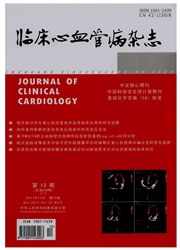

 中文摘要:
中文摘要:
目的:探讨1型多聚二磷酸腺苷核糖合成酶(PARP-1)对去甲肾上腺素(NE)诱导培养的大鼠心脏成纤维细胞基质金属蛋白酶(MMP)-1,MMP-9及金属蛋白酶组织抑制剂(TIMP)-1表达的调节作用及其机制。方法:①培养乳鼠心脏成纤维细胞,10μmol/LNE刺激细胞24h,使用实时定量PCR法检测MMP-1、MMP-9及TIMP-1的基因表达水平;使用PARP抑制剂3-氨基苯甲酰胺(3-aminobenzamide,3AB)后,观察PARP-1对上述基因表达的影响。②检测心脏成纤维细胞内活性氧(ROS)水平、PARP酶活性的变化。③采用凝胶阻滞实验检测心脏成纤维细胞内转录因子AP-1的DNA结合能力,研究PARP-1对AP-1DNA结合能力的影响。结果:NE诱导心脏成纤维细胞内MMP-1,MMP-9及TIMP-1的基因表达水平明显增加。细胞内ROS产生增加,PARP酶被激活。核内转录因子AP-1的DNA结合能力明显增强。PARP抑制剂3AB可明显减少NE诱导的MMP-1、MMP-9及TIMP-1的基因表达水平,同时显著抑制AP-1的DNA结合能力。使用抗氧化剂vitC减少ROS产生,抑制了NE诱导的PARP-1活性增加及AP-1的DNA结合,进而显著降低了NE诱导的MMP-1、MMP-9及TIMP-1的基因表达水平。结论:NE刺激心脏成纤维细胞内ROS产生明显增多,大量的ROS激活了PARP使其酶活性显著增高,PARP通过调节转录因子AP-1的DNA结合调控了MMP-1,MMP-9及TIMP-1的基因表达。PARP可能是心脏纤维化过程中的重要调节机制之一。
 英文摘要:
英文摘要:
Objective: To investigate the role of poly (ADP-ribose) polymerase in NE-induced expression of MMPs/TIMPs in cultured rat cardiac fibroblasts. Method: Cultured rat cardiac fibroblasts were divided into 4 groups. Group 1 (control group) received no treatment. Group 2 received NE (10μmol/L) treatment alone for 24 hours. Group 3 was pretreated with 15 mmol/L PARP inhibitor 3-aminobenzamide (3AB) for 1 hours, followed by additional incubation with NE (10 μmol/L) for 24 hours. Group 4 was pretreated with vitamin C (1.4 mmol/ L) followed by NE treatment for 24 hours, lntracellular ROS level was measured with ROS-sensitive fluorophore DCF-DA by Fluoromax-3 spectrofluorimeter. PARP activity of cultured cells was measured with colorimetric PARP assay kit (Trevigen). mRNA levels of MMP-1. MMP-9 and TIMP-1 were measured with real-time PCR. The DNA binding activity of AP-1 was measured with electrophoretic mobility shift assay (EMSA). Result.. Both PARP inhibitor 3AB and vitC significantly prevented NE induced (1) increase in PARP activity; (2) increases in mRNA expression of MMP-1, MMP-9 and TIMP-1 in cardiac fibroblasts; (3) increase in ROS generation; (4) increase in the DNA binding activity of AP-1. Conclusion: Activation of PARP/PARP-1 contributes importantly to the fibrosis-related gene expression of MMP-1, MMP-9 and TIMP 1 in NE treated cardiac fibroblasts through promoting AP-1 DNA binding activity.
 同期刊论文项目
同期刊论文项目
 同项目期刊论文
同项目期刊论文
 期刊信息
期刊信息
